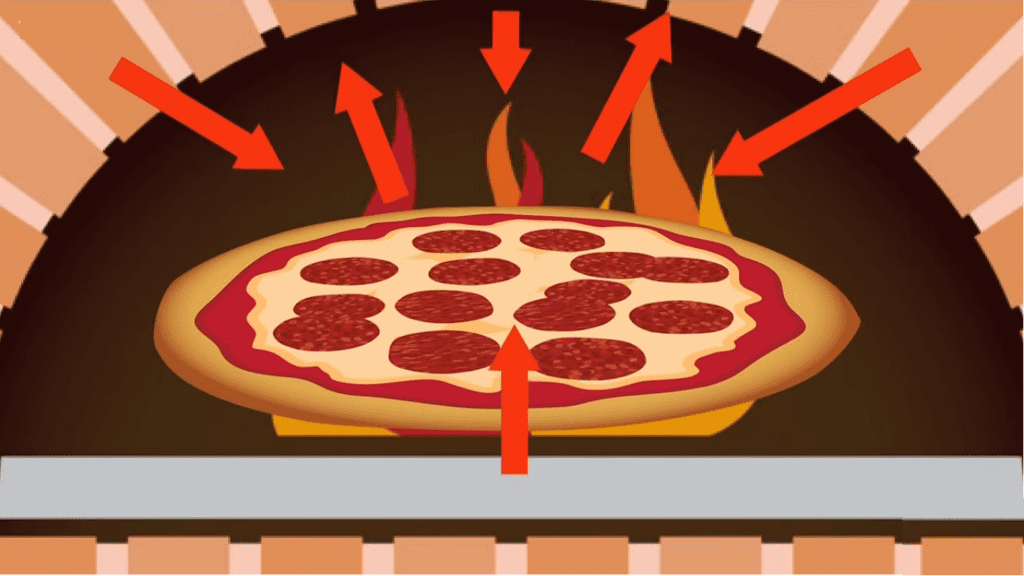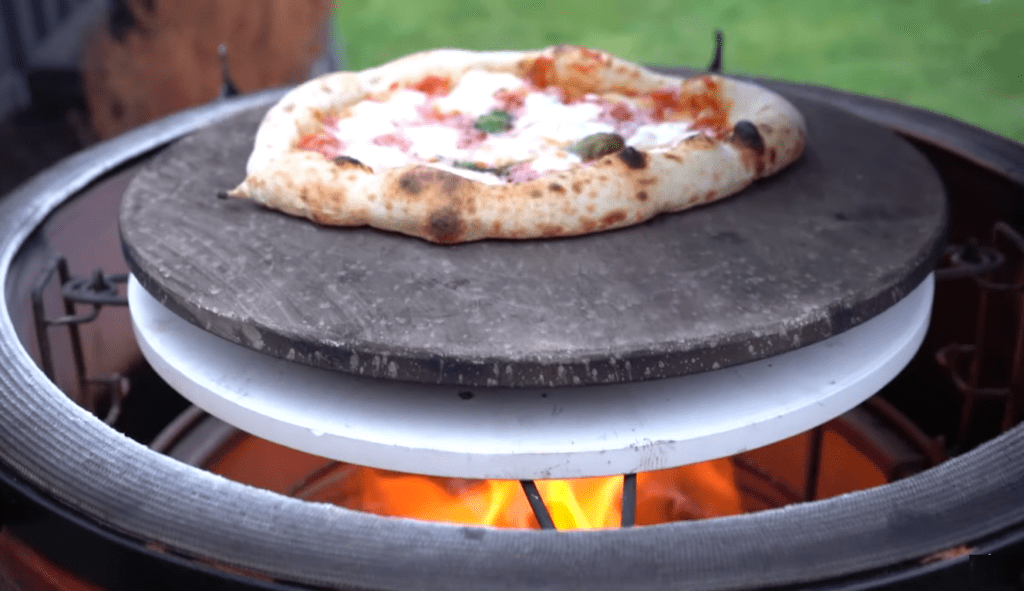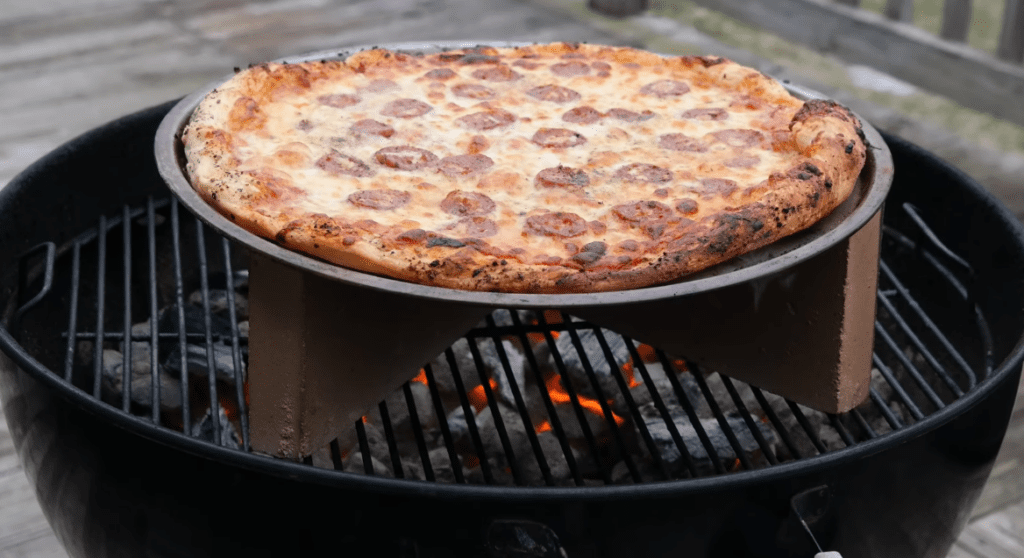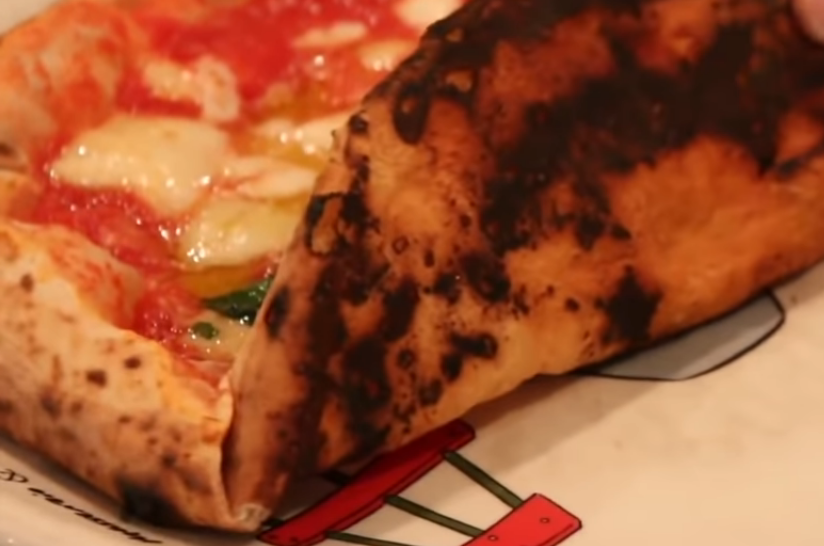Do you want to know what causes the burnt pizza bottom and how you can fix it? The cause-and-effect principle certainly works here. You can fix burnt pizza bottoms by spotting the exact cause and eliminating it in just a minute. In this article, I’ll not advise you to grind the pizza bottom to fix it!
Similarly, you don’t need to follow several steps. Just get your checklist, know what wrong you have been doing, fix it, and all trouble is gone.
This detailed guide will help you understand how pizza dough, toppings, temperature, and time work together to get you perfectly cooked pizza and where all wrong happens. Let’s get into the article.
Key Take Aways
To prevent a burnt pizza bottom:
- Preheat oven to the correct temperature with even heat distribution.
- Place the pizza on the middle oven rack for even cooking.
- Avoid overloading your pizza with too many toppings.
- Use a pizza stone or baking steel for even heat distribution.
- Monitor the pizza; remove when the cheese is melted, and the edges are golden brown.
- Avoid excessive sugar in the dough; consider reducing toppings.
- Moderate flour when stretching dough; shake off excess.
- Pre-cook raw toppings before spreading them on the pizza.
- Strain cheese to remove excess water; dry with paper towels.
- Use moderation with oil and sugar in the dough.
- Regularly check the pizza bottom for doneness.
- Use less flour under the dough during stretching.
- Toss the pizza properly while stretching.
Top Reasons to Cause Burnt Pizza Underneath
The perfect pizza is a delicate balance of crust, sauce, toppings, cooking temperature, and time. Anything that disrupts this balance can cause the pizza bottom to overcook. To help you figure out the contributing factors to trouble your pizza, I’ve listed them below.
1. Pizza Oven Temperature
Primarily, 2 things affect your pizza: duration and temperature. If any of these 2 exceeds the required limit or the balance is disturbed, the result will be a burnt pizza crust.
To put it simply:
- Heat
- Time
Wood-fired pizza ovens offer the best heat for cooking pizza, with temperatures reaching 850-900°F (450-500°C) and cooking times under 90 seconds. Pizza stones in these ovens typically maintain a surface temperature of around 400°C (750°F).
Yet, the real problem arises when you cook pizza using non-conventional methods like electric ovens, grills, and air fryers, which lack the intense heat needed for optimal pizza cooking.
To compensate, use DIY solutions like pizza stones or pizza steel to maintain a cooking temperature of 500-800°F (260-430°C).
So, no matter what method you use to cook pizza, you have to get maximum and even heat.
2. Type of Oven
Different ovens have different personalities. A conventional oven may have hot spots, while a convection oven circulates hot air more efficiently. Knowing your oven’s quirks allows you to adjust temperature and placement accordingly.
3. Placement in the Oven
Where you position your pizza in the oven matters. Placing it too close to the bottom can expose the crust directly to intense heat, causing it to burn. Optimal placement is usually on the middle rack, ensuring more even heat distribution.
4. Lack of Insulation
The surface on which your pizza rests matters. Placing it directly on a hot oven rack can lead to uneven cooking. A pizza stone or a preheated pizza pan provides insulation, shielding the crust from direct heat and preventing untimely scorching.
5. Pizza Baking Time
https://mama-cucina.com/preheat-pizza-stone/
The balance between pizza cooking time and temperature is the ultimate thing that guarantees a fantastic pizza.
Gas or woodfired ovens cook the pizza in seconds. Yet, in electric ovens, owing to the low-temperature range, it takes far longer to cook the pizza.
For instance, an electric pizza oven can hardly exceed the temperature range of 450-500 °F (230–260 °C). This range is 50% lower than the wood pizza ovens.
In such a case, you need to adopt techniques like:
- Using preheated pizza stones or pizza steel to help the cooking surface retain more heat
- And cooking pizza for a longer time of 10-15 minutes.
6. Pizza Crust Thickness or Unevenness
Too thin or too thick crust pizza can be a culprit in your way of cooking a pizza. For example, a thin crust will cook faster, and the leopard spotting can, unfortunately, turn into burnt pizza crust.
On the other hand, when looking forward to cooking a thick crust, you might miscalculate the time and cook it longer to cause the pizza bottom to burn.
7. Cold Pizza Dough
Frozen, unthawed pizza crust, contrary to your hopes, can burn. How?
When placed in the hot stone, the top section will still be cold and look undercooked, while simultaneously, the lower crust will soon thaw and cook at a normal pace. Thus, though deceived, your pizza crust will become burnt underneath.
We’ll advise you always to thaw your pizza crust and only put it in the oven when it has reached room temperature.
8. Pizza Dough Hydration Level
Pizza dough hydration means the water-to-flour ratio. The higher the hydration is, the more time a pizza will need to cook.
Hydration level does not significantly affect pizza cooking in a wood or gas oven. Whether it’s 60% or 80% hydration, the pizza will cook in under 60 seconds, and you’ll have to monitor it carefully.
However, an electric oven will demand more time, and vice versa for a low-hydration pizza crust. So, if you notice your pizzas burning constantly, it can be because the hydration is lower: 50-60% and your pizza oven temperature is high.
9. Pizza Toppings
Pizza toppings are the tastiest but most annoying when you overload your pizza. Pizza lovers often lose their pizza by burning it because of many toppings and sauces to secure more flavors.
The result is that you’re gazing at the pizza toppings in your oven and waiting for them to be cooked, which takes longer, while the pizza’s crust is already burnt.
If you think you’ve been making this mistake, here are a few key points to remember:
- Only load your pizza with a few uncooked or watery toppings.
- If you’re using raw toppings, please cook or sautee them before spreading them on the curst.
- For extra cheesy pizzas, strain the cheese in a double strainer for 1-2 hours, then pat dry with paper towels to remove excess moisture.
- The key to fully cooked pizza toppings is seeing bubbling, and your pizza is done.
So, forget about using many uncooked toppings or aiming to cook them in the oven.
10. Higher Oil or Sugar Content in Dough
The dough’s oil content plays a crucial role. Excessive oil can accelerate browning, making the crust prone to burning. Strike a balance; don’t let the dough drown in oil. A moderate amount ensures a golden crust without the undesirable char.
Sugar in the dough isn’t just for sweetness; it affects browning. Too much sugar can turn your pizza into a fiery inferno. Keep the sugar content in check to control the crust’s color and prevent it from taking on a dark, burnt hue.
11. Type of Flour
Not all flours behave the same way in the oven. Experimenting with different types can alter the crust’s texture and browning. A finer flour might lead to a more delicate crust, while a heartier one may lend itself to a robust, rustic finish.
12. Uncleaned Pizza Stone
Uncleaned pizza stones can cause pizza to burn underneath due to residue buildup. Over time, this residue can act as an insulator, preventing heat from evenly distributing across the stone’s surface. As a result, certain areas of the pizza cook faster than others, leading to burnt patches. Regularly cleaning your pizza stone with a stiff brush and warm water ensures even heat distribution and prevents burnt-bottom pizzas.
13. Not Checking the Pizza Bottom
When cooking a pizza, you must balance how brown your pizza should be from top to bottom; it’s where the wood pizza ovens work.
The pizza maestros check the pizza bottom for doneness, then pick the pizza on steel and color it near the flame. They sometimes wait for the pizza edges to be well done when it is lying on a hot surface.
14. Using too much flour When Stretching the Pizza Crust
Probably, your pizza crust has a lot of dry Italian pizza flour (semolina and plain flour) when you’re stretching it, and this excess flour burns inside the oven and causes a burnt pizza bottom. You can avoid it by using less flour under the dough, tossing your pizza properly while stretching (primarily), and using a perforated pizza peel (as a secondary measure).
(Do you think everything is fine with your pizza? In the next section, we’ll discuss each cooking method and the resulting burning of your pizza crust. It’ll help you find the exact reason.)
Why Causes the Pizza Bottom to Burn in a Wood or Gas Pizza Oven?
Woodfired or gas-fired pizza ovens work similarly. A huge fire contributes to the entire pizza oven convection by heating the walls, floor, and roof. Yet, this temperature is far higher, almost 800-900F.
Still, the stone surface is hotter near the heat source: wood or gas fire, and usually, it’s advisable not to place pizza near the heat source.

Many things can burn a pizza in a woodfired oven besides those mentioned in the second section of this article.
- You have a thin-crust pizza that can hardly tolerate such heat, or your crust is unevenly stretched. Some spots are thin, and others are thick, and that’s why the pizza is overcooked.
- You might place the pizza near the heat source, which is the hottest, while a pizza oven has 3 spots: a colder spot near the door, a moderately hot area in the middle or opposite the fire, and the hottest near the fire.
So, you must find a suitable area by checking the oven floor using an infrared thermometer. As a rule of thumb, the pizza stone surface where you place your pizza should be about 430 degrees centigrade (about 800 F).
- As stated earlier, the dry flour stuck to your pizza bottom can be burned in the oven and cause a burnt pizza crust.
- You use watery cheese, more sauce, or pizza toppings. Therefore, you have to wait to cook them, which is a bad idea, as discussed already.
- And lastly, be vigilant, and pay attention to your pizza. Keep checking the bottom using a stainless steel pizza peel, and if it’s done, shift the pizza on the peel and get it more heat by nearing the main fire.
What Causes Burnt Pizza Bottom in Portable Gas Ovens: Ooni Koda, Karu, or Roccbox?
Portable gas ovens like Ooni Koda, Roccbox, or Karu work like woodfired pizza ovens, except that they’re small; you can only cook 1 pizza at a time. Therefore, they also have the same heat zones: almost 800 temperature in the mid, higher near the heat source, and a bit low near the opening. So, you have to take care of your pizza stone temperature before placing it, and when it’s cooking, be watchful so that you may rotate your pizza to ensure even heat distribution. Besides this, consider the points listed below.
- When you stretch your pizza crust, it most likely has a lot of dry flour (semolina and plain flour), and this surplus flour burns inside the oven. Thus, it results in a scorched pizza bottom.
- You use watery cheese, more sauce, or more pizza toppings, and so you have to wait for them to cook, which is a perfectly awful idea, as previously mentioned.
- Finally, be careful and pay attention to the pizza you’re cooking; continuously check the bottom with a stainless steel pizza peel, and if it’s done, shift the pizza on the peel and increase the heat by moving it closer to the main fire.
- Your pizza crust is either too thin to withstand such heat or unevenly stretched, with some places thin and others thick. It’s the reason why pizza gets overdone.
- The pizza stone hot zones are less utilizable in the case of portable ovens. It’s because the small ovens accommodate only one pizza. Yet, this one pizza will cook differently: even in the middle, it is more cooked at the side near the fire and less cooked near the pizza oven opening, so you have to rotate it. Since the pizza oven is extremely hot, you must be super fast.
What Causes Burnt Pizza Bottom on Grills?
Finally comes the most challenging part of cooking a pizza: it’s on a grill or charcoal grill like a Weber Kettle or Kamado Joe. You can’t simply place the pizza on the grill grates.
Instead, you must place it on a preheated pizza stone set to the maximum temperature your grill allows.
Still, it burns!
If your pizza recipe is just perfect, the only solution is to ensure that the temperature of the pizza stone and inside the girl dome is the same. This way, your pizza toppings and pizza button will cook simultaneously.
How can you do it, then?
Follow the pizza baking instructions specific to the grill type. For example, charcoal grills can easily attain a temperature of 700 degrees higher, while gas grills don’t exceed 550F.
Most of the time, the charcoal grills burn the pizza bottom because the pizza stone’s temperature limit of 500 is crossed easily, and your pizza stone can be as high as 400 degrees centigrade.
THEN, WHAT SHOULD YOU DO?
LIFT THE PIZZA STONE!
The key is preheating the grill the highest and creating the gap between the heating source, i.e., charcoal. Here is what you can do:

- Place 1 pizza stone directly over the grill grates and then place the 2nd pizza stone over it after creating the gap to produce convection. You can use anything between these two pizza stones, like nuts or pebbles.
OR

- Use any barrier between the stone and grates to lift it about 4-6 inches higher, as you can see here. The best way will be using a fire brick. Cooking pizza on a charcoal grill will take 10-15 minutes.
Thus, this single trick can save your every pizza. Also, remember to preheat your pizza stone properly before placing the next pizza on it.
No matter what charcoal grill you use, your infrared thermometer must record the temperature between 400C and 700F degrees of the pizza stones.
And, if you use a gas grill, the pizza stone must be near 500F temperature, for your gas grills can’t exceed this limit.
What May Cause the Pizza Bottom to Burn in a Convection Oven?
Baking ovens can hardly be responsible for any such problem, except that the convection fan is malfunctioning and not circulating the heat properly. Another reason is that the pizza stone’s heating elements produce more heat.
You can know this problem using an infrared thermometer by checking the pizza stone surface’s temperature in the middle and edges. If the bottom heating elements in the oven are creating hot spots in your pizza stone, place the pizza stone in the upper rack and use parchment paper on the stone.
And, if you burn your pizza crust often while trying to cook the toppings, the solution is the simplest.
Raise your pizza stone higher to catch more heat from the ceiling heating elements to cook the toppings. Place the pizza stone on the upper rack or lift it higher using a baking sheet or pan underneath.
Remember, when you place pizza on the stone, turn the oven dial to highest, preheat the stone for 1 hour, and keep checking your pizza.
If all is set, then the problem can only be in the pizza crust or toppings.
We’ve already discussed the factors regarding pizza recipes: toppings or dough.
ENJOY YOUR PERFECTLY COOKED PIZZA!
mama-cucina.com is a participant in the Amazon Associate program and will earn from qualifying purchases.

